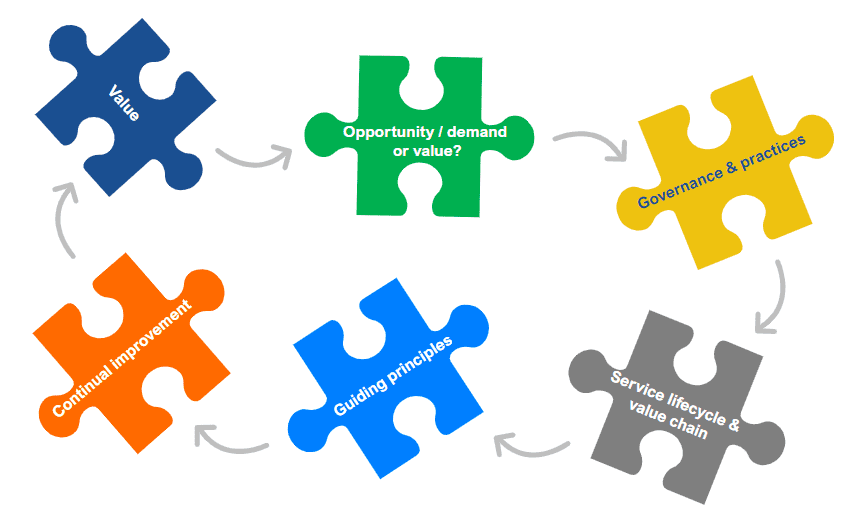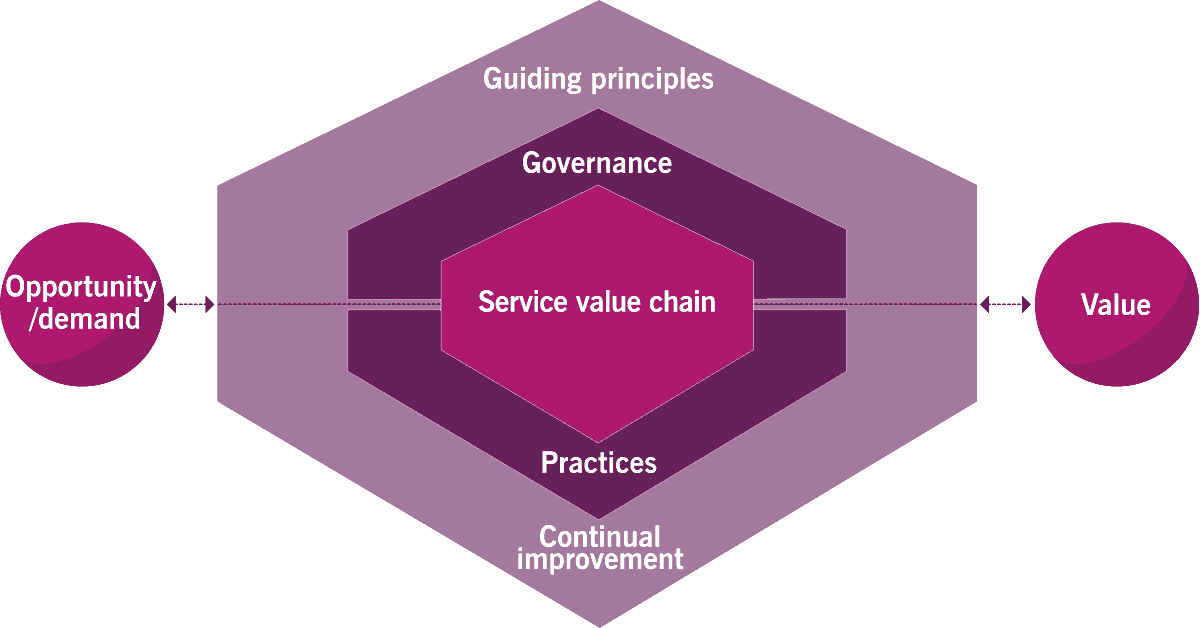The ITIL 4 Service Value System
Everything you need to know about the ITIL 4 SVS
07 mins read
Many useful articles provide theoretical explanations of what the ITIL 4 Service Value System (SVS) is from a high level, but what does it mean, and why is it important to understand how it works?
As a basic overview, the ITIL 4 SVS uses complementary components that work together to take the demand/opportunity requirements and produce value. This is usually through the delivery of products and services. The ITIL 4 SVS is made up of the following components:
- Guiding principles
- Governance
- Service value chain
- Practices
- Continual improvement
Piecing it all together

Show me the value
Before diving into the details, it is important to pause and consider what "value" means and how it is quantified. This may sound simple, but it is more complicated than you think. To define "value," you must consider what is important to you, your department, your organization, your partners and suppliers, and your customers. Straight away, you will realize that it is unlikely that those stakeholder groups will have the same priorities, objectives, or definitions of "product," "service," and "value."
The four dimensions of service management balance these stakeholders and entities together (organizations & people and partners & suppliers), along with information & technology and value streams & processes. This enables you to create an integrated approach to balance the needs and wants of each dimension with a focus on delivering and co-creating value.

Value is not always financially driven. Positive employee and customer experience are also important measures of value.
Value will not necessarily come with a pound or dollar sign attached, as not all value is financially driven. There is an increase in the measurement of experience (user, colleague, customer) and the value derived from a positive experience in addition to the historic KPI metrics such as service availability, volume of incidents and requests, etc.
Which came first - the opportunity/demand chicken or the value egg?
We will not discuss the potential answers to this question, but the SVS shows opportunity/demand on one side and value on the other. In the official diagram depicting the SVS (shown below), both opportunity/demand and value have a two-way arrow connecting them to the SVS. So that begs the question of which comes first? The answer depends on what you are delivering and where you are starting from.

For example, if you are defining a new service based on a gap in the market that you want to fill, you are likely to start with opportunity/demand. Whereas if you have identified that the current tooling for managing your service incidents and requests is outdated, time-consuming, adds no value, and needs replacing, you're likely to start with value. The two sides of the SVS work together because the opportunity/demand needs to create and deliver value; because if it does not, you need to ask yourself, "Why are we doing this?".
Let's be honest
For the SVS to work effectively, there needs to be some form of governance and standardization of processes to ensure consistency. There also needs to be an understanding of what works well and where improvement opportunities exist.

Governance is often considered unnecessary red tape and bureaucracy, but it doesn't have to be.
It is common in fast-paced environments for "governance" to be considered red tape or unnecessary bureaucracy. The reality is that governance and its various control mechanisms can optimize the risks associated with change and evolution. This can help organizations support the delivery of services with a focus on quality, consistency, and value.
The ITIL 4 practices (split into general, service, and technical management practices) are the tools used for managing services. These practices are your control mechanisms associated with your governance and risk management. If you are about to start your journey to implement ITIL 4, remember to go back to the question of value before diving in to implement all 34 practices at once.
The key point to remember for governance and practices is to keep people honest and consistent with clear assignments of responsibility and accountability. These practices, combined with your tooling, allow you to manage the various controls and enable effective collaboration with all your stakeholders.
Stay in your lane
The guiding principles (seven in total) of the SVS are below, explaining what they really mean. These may seem obvious or basic guidelines to follow, which they are, but from a strategic leadership standpoint, they are a solid reminder to keep one foot firmly on the ground when defining a strategy, designing, and delivering services.
- Focus on value - prioritizing what is important
- Start where you are - considering what base you are working from to understand where you want to go
- Progress iteratively with feedback - deliver bite-sized chunks while asking for input and opinions
- Collaborate and promote visibility - avoid siloed working by working with others to co-create value
- Think and work holistically - reflect and work towards the bigger picture, being objective
- Keep it simple and practical - not over-complicating things and being realistic
- Optimize and automate - making the most of the tool you have and taking advantage of automation
Working with these guiding principles as your strategic base will develop strong foundations, a culture of innovation and collaboration, and deliver the value you seek to achieve.
Life is a rollercoaster
The ITIL 4 Service Value Chain is the piece of the SVS puzzle concerned with the delivery pipeline or service lifecycle for a product or service. In the earlier versions of ITIL, the service lifecycle appears to be a linear or waterfall process; however, this is rarely the case (even if you follow a waterfall methodology for delivery). Realistically, you will make mistakes, learn, adapt to changing requirements, etc.
This value chain approach is made up of the following, with the inputs & outputs being demand and value from the products and services created/changed:
- Plan
- Improve
- Engage
- Design & transition
- Obtain/build
- Deliver & support
Are we there yet?
Let's talk about continual improvement - a crucial component of the SVS. Referring to the guiding principles discussed earlier, the second is "start where you are," which is like the second step of the continual improvement process of "where are you now?". Regardless of how successful a service is, it is important to validate that the value being produced meets requirements. It is also critical to continually evaluate whether improvement opportunities could enhance experience and increase value.

Question the status quo and avoid "we've always done it like this."
Looking for improvement opportunities does not mean making change for the sake of change. Continually evaluate whether the original goals are being met, if there is a new or changed vision to achieve, or if you need to correct your current course of travel or evolve. Always question the status quo and avoid the stance of "we've always done it like this" and similar statements, typically resulting in stagnation followed by decline.
Colouring outside the lines

For any organization or technology function to be effective, it needs to understand from a holistic perspective how the various pieces fit together to deliver its products & services.
Why is it important to know about the ITIL Service Value System and consider it when delivering any product or service? This is quite simple to answer - for any organization or technology function to be effective, it needs to understand from a holistic perspective how the various pieces fit together to deliver its products & services. Using the ITIL Service Value System brings together all the various components, like jigsaw pieces, that fit together to create a big picture.
ITIL, including the SVS and its component parts, can and does apply to more than the technology function in an organization. Enterprise service management has been around for years, and with the ITIL 4 principle "keep it simple and practical," aligning the organization's strategic approach to follow the ITIL framework and SVS is exactly that. If you know what value means to you and all your stakeholder groups, you can design and operate services that meet multiple needs and goals - co-creating value.
Following the ITIL 4 guiding principles will give you a solid base to work from, allowing for integration with other delivery methods such as Lean or Agile. It is heavily focused on collaboration and working with others to provide the best outcome and focusing on value - this is an excellent foundation to work from to deliver high-quality, effective, value-driven products and services.

